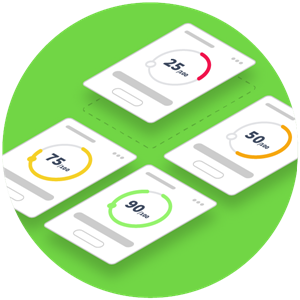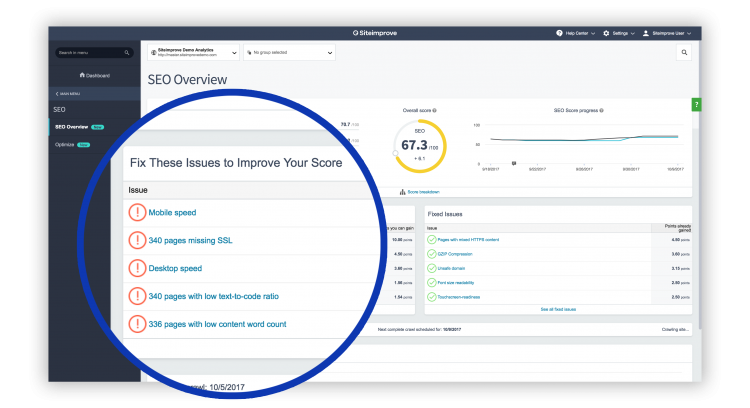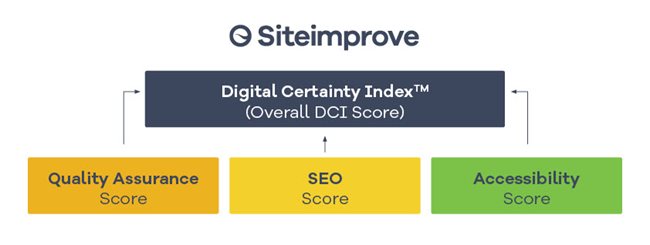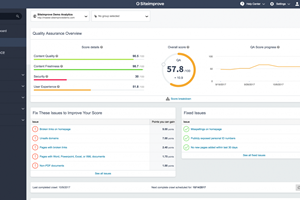Siteimprove Helps Brands Act with Digital Certainty
Maintaining a company's consistent brand identity is extremely important but it is easier said than done, especially for large organizations with hundreds of thousands of websites around  the world. A company's brand identity consists of a wide range of parameters from specific fonts, colors, guidelines for templates and layouts to consistent use of terminology, language clarity, and the detection of prohibited terms and phrases. With all these factors and the explosion of content, it can become really overwhelming for brands to be concerned about their ability to impose effective quality control across all its content touchpoints. Therefore, Siteimprove, a Software-as-a-service (Saas) company that provides services to help audit, optimize, and manage websites, has announced a new service called the Digital Certainty Index (DCI) to help organizations assess and manage their digital presence.
the world. A company's brand identity consists of a wide range of parameters from specific fonts, colors, guidelines for templates and layouts to consistent use of terminology, language clarity, and the detection of prohibited terms and phrases. With all these factors and the explosion of content, it can become really overwhelming for brands to be concerned about their ability to impose effective quality control across all its content touchpoints. Therefore, Siteimprove, a Software-as-a-service (Saas) company that provides services to help audit, optimize, and manage websites, has announced a new service called the Digital Certainty Index (DCI) to help organizations assess and manage their digital presence.
Speaking to CMS-Connected, Torben Rytt, CEO of Siteimprove said: “Organizations spend enormous amounts of energy on their websites, but measuring the impact of those efforts on quality and performance has been very hard to do until now. The DCI score serves as an easy, credible, and objective measurement of a website’s quality, enabling customers to measure progress over time. It will be exciting to see how the DCI evolves and how organizations improve their sites based on the insights they gather from the score.”
In a nutshell, Siteimprove’s DCI gauges a website’s performance based on three major categories, namely quality assurance, SEO, and accessibility. The platform provides a summary of a website's performance in these three core areas through the overall DCI Score, which ranges from 0-100. From there, users can dig deeper through their sub-scores based on the sub-categories which we will discuss here shortly.
To get an inside scoop on the platform and its new addition, DCI, our reporter Laura Myers had a chance to catch up with Roger J Fuhrman, Vice President at Siteimprove, on this topic during at interview at Kentico's one-day event in Chicago.
How’s the Digital Certainty Index Calculated?
The DCI is calculated based on over 200 individual checkpoints that have been profoundly indicated by industry experts. The platform provides not only an overall DCI score but also the sub-scores as well as practical advice for improvement.

On top of these, the users additionally receive a benchmark based on their location and industry, so they could compare themselves with their peers to understand where they perform well and where they need an improvement.
As mentioned, there are three core categories of quality assurance, SEO, and accessibility where users receive their sub-scores from. To get a deeper understanding of the overall score and the recommendations offered, it bears diving into what these sub-scores involve.

The Quality Assurance (QA) Score
According to the vendor, the Quality Assurance (QA) Score is a measure of the credibility and usability of the user-facing characteristics of your site. To be more exact, the score is  calculated based on these four subcategories: Content Quality, Content Freshness, User Experience, and Security. The interesting thing about the platform is that it provides not only recommendations to improve your score but also puts those recommendations in order based on the subcategory’s weightings aggregated. According to the platform, user experience, for instance, has the highest weighting priority, whereas content freshness has the lowest impact on the sub-score. This capability is great because that way, organizations wouldn’t get so overwhelmed by the issues to be fixed as prioritizing the tasks has already been taken care of.
calculated based on these four subcategories: Content Quality, Content Freshness, User Experience, and Security. The interesting thing about the platform is that it provides not only recommendations to improve your score but also puts those recommendations in order based on the subcategory’s weightings aggregated. According to the platform, user experience, for instance, has the highest weighting priority, whereas content freshness has the lowest impact on the sub-score. This capability is great because that way, organizations wouldn’t get so overwhelmed by the issues to be fixed as prioritizing the tasks has already been taken care of.
When I saw that the score includes content quality, I wondered if it means just misspellings or if there is more involved to the measurement. It turned out, the platform gauges content quality also based on how accurately and quickly users are able to grasp it. For example, a complex word is defined by the Siteimprove algorithm as a polysyllabic word, which is a word made up of more than three syllables. After carefully examining whether words are really complex to comprehend for readers, the platform compiles a list of polysyllabic words found on the page.
On top of these, under this major category, the platform unveils broken links, images with size over 1 MB, links to unsafe domains, the frequency of document and media file updates, and so on.
The Search Engine Optimization (SEO) Score
According to Siteimprove, the SEO Score is a measure of how well the user-facing and technical aspects of your site contribute to search engine optimization, and ultimately, higher rankings and organic traffic. This category also consists of four sub-categories: Technical, Content, User Experience, and Mobile. Siteimprove sees how well the technical elements of a site enable it to be accessed, crawled, and indexed by search engine bots which drives organic traffic.
The technical elements are important not only for driving more traffic but also establishing and maintaining your digital dignity and respectability. External links to unsafe domains on your website, for instance, could contain phishing, malware, or unwanted software, meaning you may harm your visitors and user experience unintentionally. Technical SEO is often an afterthought as the initial main focus is always on how fast a website can go live but according to Siteimprove, a significant amount of issues can be avoided if technical SEO is taken seriously early on.
On top of these, under the scope of this major category, the platform checks how SEO-friendly URLs, visuals, and navigation are, how fast the server loads pages, indexability of the site and meta-content, mobile responsiveness, and so on.
The Accessibility Score
According to Siteimprove, the Accessibility Score is a measure of how well your site meets the standards set out in WCAG (Web Content Accessibility Guidelines) 2.0 which covers a wide range of recommendations for making Web content more accessible. This category consists of three sub-categories: Errors, Warnings, and Pages with multiple Level A/AA errors.
For those who are not familiar with web accessibility, let me give you some brief background information on those standards. Some 15% of the world's population, an estimated 1 billion people, have disabilities. In the U.S, one out of every five adults has a disability, according to the Centers for Disease Control and Prevention. To address this issue, nearly a decade ago, the regulations (Title II and III of the Americans with Disabilities Act (ADA)) were introduced in an effort to remove barriers to create an inclusive and accessible society for all, in both a real and virtual world as they prohibit discrimination on the basis of disability. The focus of the legislation requirements were initially on places of public accommodation, however, over time, the scope expanded from the physical aspects of accommodation into their digital presence, and that’s where things have gotten complicated as for any organization that receives federal funding or does business with the government, the act requires agencies to make their electronic and information technology accessible to people with disabilities by complying with the ADA Standards. Department of Justice (DOJ), which issues those standards, considers a website “accessible” if it complies with the Level AA standards of the Web Content Accessibility Guidelines (WCAG) 2.0.
WCAG 2.0 aims to make online content accessible to deafness and loss of auditory capacity, limited visual acuity, and blindness, cognitive medical conditions, learning disabilities, speech disabilities, movement-based limitations, photosensitivity, other types of disabilities which impede content consumption.
Now that we all have a general idea about the web accessibility standards, let’s circle back to how Siteimprove can help organizations improve their web accessibility. The platform determines how well your website adheres to WCAG 2.0 based on the number of automatically detected failures to meet success criteria at Level A, Level AA, or Level AAA ("errors"). While the vendor warns that it is not possible to fulfill all Level AAA success criteria for some content, the platform helps the user have few or no errors at Level A, AA, and AAA on the website.
My POV
Many argue the concerns around website privacy and security create a dilemma for marketers and merchandisers on the quest for personalization. I beg to differ because there are also many studies suggesting that consumers are eager to have organizations they trust use some of their personal data in order to provide personalized and targeted products, services, recommendations, and offers as long as there is a fair trade in exchange for their data. To do so, it is paramount to build a life-long trust between a brand and buyers, and it becomes even more crucial when your business is operating in the heavily regulated industries such as finance, insurance, and real estates. As Fen Osler Hampson, director of CIGI's Global Security and Politics program, said: "The lifeblood of the Internet is trust, and when that is damaged, the consequences for the digital economy are nearly irreparable."
On top of the security and brand equity maintenance purposes, it is imperative to have a technology that can ensure your websites stay compliant with your search engine strategy as well. Therefore, I found how Siteimprove calculates DCI quite on point and straightforward. As having an engineering background, my favourite feature of this new service is how each task is tied to a numerical value which enables users to watch their DCI score climb as they address the issues found. To me, it encourages the team and makes website goals more tangible and attainable.

Venus Tamturk
Venus is the Media Reporter for CMS-Connected, with one of her tasks to write thorough articles by creating the most up-to-date and engaging content using B2B digital marketing. She enjoys increasing brand equity and conversion through the strategic use of social media channels and integrated media marketing plans.

Laura Myers
A digital business, marketing and social media enthusiast, Laura thrives on asking unique, insightful questions to ignite conversation. At an event or remotely, she enjoys any opportunity to connect with like-minded people in the industry.